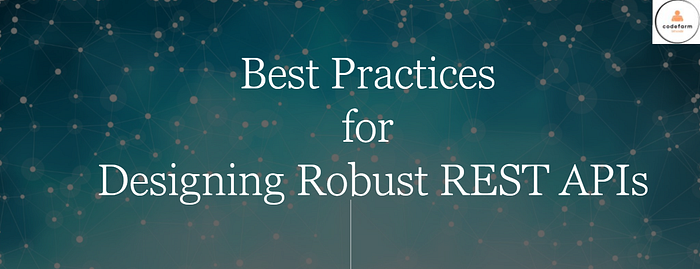Best Practices for Designing Robust REST APIs

Introduction
Designing RESTful APIs that are both efficient and user-friendly is crucial for creating successful web applications. Whether you’re an experienced developer or new to API design, following best practices ensures your APIs are scalable, maintainable, and provide a seamless experience for your users. In this article, we’ll explore ten essential best practices to consider when designing REST APIs on any platform. By following these guidelines, you can create APIs that not only meet the current requirements but also adapt well to future needs.
Clear and Consistent Naming Conventions
Maintain a consistent naming convention for endpoints, HTTP methods, and query parameters. Use meaningful and intuitive names that reflect the purpose of the resources and actions they represent. Consistency simplifies API navigation and reduces confusion for both developers and consumers.
Example: Instead of using /getArticles, use /articles to represent the endpoint for fetching articles.
Consistency in naming makes API usage more intuitive for developers.
Versioning for API Longevity
Include versioning in your API URLs to ensure backward compatibility as your API evolves. This allows you to make necessary changes without breaking existing integrations. Incorporating versioning early in your API design prevents disruptions for your users and saves time in the long run.
“Versioning is not just about software; it’s about communicating with your API’s users and respecting their needs.” — Kin Lane
Use HTTP Methods Appropriately
Adhere to the appropriate HTTP methods (GET, POST, PUT, DELETE, etc.) for the intended actions. Use GET for retrieving data, POST for creating resources, PUT for updating resources, and DELETE for removing them. This semantic consistency improves the predictability and reliability of your API.
“Use POST when you want to create a new resource. Think of it like submitting a form on a website.”
Consistent Response Structures
Design consistent response structures for your API. Provide meaningful status codes and standardize error responses with clear error messages and error codes. A well-structured response format helps developers quickly understand and handle API responses.
“Consistency in response structures can save developers hours of frustration and debugging.”
Authentication and Authorization
Implement strong authentication mechanisms to secure your API endpoints. Use industry-standard authentication protocols such as OAuth 2.0 to ensure proper authorization and data protection.
“OAuth 2.0 provides a secure and standardized way for users to grant third-party applications limited access to their resources.”
Pagination and Filtering
Incorporate pagination and filtering options for resource-heavy endpoints. Provide parameters to control the number of results per page and enable filtering based on relevant attributes.
“Pagination prevents overwhelming users with excessive data and allows for smoother data retrieval.”
Caching for Performance
Integrate caching mechanisms to optimize API performance. Leverage HTTP caching headers like ETag and Last-Modified to reduce server load and decrease response times.
“Caching can significantly improve API response times and reduce server strain, benefiting both developers and users.”
Input Validation and Sanitization
Validate and sanitize input data to prevent security vulnerabilities like SQL injection and cross-site scripting (XSS). Implement validation checks on incoming data to ensure it adheres to expected formats and values.
“Validating and sanitizing input data is a critical step in safeguarding your API from malicious attacks.”
Documentation is Key
Create comprehensive and user-friendly API documentation. Explain each endpoint, its purpose, required parameters, request and response formats, and usage examples.
“Good documentation is the foundation of successful API adoption. Make it easy for developers to integrate with your API.”
Testing and Monitoring
Regularly test your API endpoints to identify bugs, performance bottlenecks, and security vulnerabilities. Implement monitoring and logging to track API usage, errors, and response times.
“API testing and monitoring ensure that your API is reliable and performs well, providing a positive user experience.”
Conclusion
Adhering to these best practices will enable you to design REST APIs that are robust, scalable, and user-friendly on any other platform. Consistency in naming, versioning, and response structures, coupled with strong security measures and effective documentation, lays the foundation for successful integration and growth. Remember that the goal is to provide developers with a seamless experience, fostering positive interactions and helping your platform flourish in a dynamic digital landscape.
More
- https://apievangelist.com/
- https://oauth.net/
- API versioning — https://www.youtube.com/watch?v=z4YEFDelGQ4
- Antipatterns for microservices — https://www.youtube.com/watch?v=kfHvKpQwkXo
